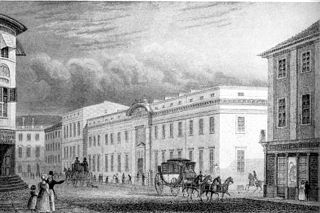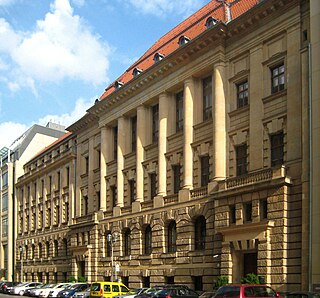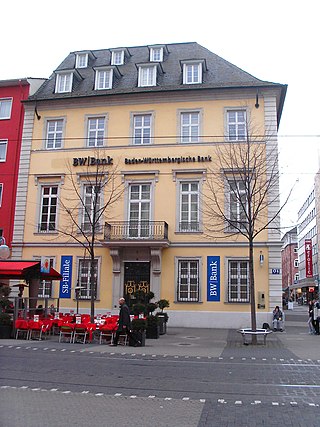
The Reichsbank was the central bank of the German Reich from 1 January 1876 until liquidation in 1945.

Dresdner Bank AG was a German bank, founded in 1872 in Dresden and managed from Berlin until 1945 and Frankfurt in the postwar era. Long Germany's second-largest bank behind Deutsche Bank, it was eventually acquired by Commerzbank in May 2009.

Commerzbank AG is a global German universal bank headquartered at Commerzbank Tower in Frankfurt. The bank was founded in Hamburg in 1870 and is today among the largest credit institutions in Germany, with total assets of €534 billion as of the end of September 2022. With over 15 percent ownership, the Government of Germany is the bank's biggest shareholder.

The A. Schaaffhausen'scher Bankverein was a bank in Cologne, initially founded in 1791. In 1848 it was reorganized as a joint stock company, the first to be legally recognised as a bank in what is now Germany. It was purchased in 1914 by the Berlin-based Disconto-Gesellschaft, and its brand finally disappeared in 1929 as the latter was in turn merged with Deutsche Bank.

Petra Roth is a German politician of the Christian Democratic Union (CDU). She was the Mayor of Frankfurt from 1995 to 2012. In addition she twice served as president of the Deutscher Städtetag, resuming her previous post there in 2009. The group is the head organization and lobby group for all German cities vis-à-vis the Cabinet of Germany, the German Bundestag, the Bundesrat of Germany, the European Union (EU) and many organizations.
Carl Fürstenberg was one of the most prominent German bankers of the late nineteenth and early twentieth century, and was responsible for the revival of the German mining industry during his era. Fürstenberg was born on 28 August 1850 to Jewish parents in Danzig (Gdańsk). While working at a West Prussian textile mill throughout his childhood, he apprenticed under local banker R. Damme. At the age of seventeen, he moved to Berlin.

The Bethmann family has been remarkable for the high proportion of its male members who succeeded at mercantile or financial endeavors. This family trait began in medieval northern Germany and continued with the Bethmann bank, which Johann Philipp Bethmann (1715–1793) and Simon Moritz Bethmann (1721–1782) founded in 1748 and soon catapulted into the foremost ranks of German and European banks. Even after the bank's sale in 1976, there are Bethmanns engaged in commercial real estate and forestry in the 21st century.

Deutsch-Asiatische Bank (DAB) was a foreign bank in Asia, founded in 1889 in Shanghai. Its principal activity was trade financing, but together with English and French banks, it also played a role in the underwriting of bonds for the Chinese government and in the financing of railway construction in China.

The Darmstädter und Nationalbank, in shorthand Danat-Bank or Danatbank, was a large German joint-stock bank. It was formed in 1922 from the merger of the Bank für Handel und Industrie (Darmstadt), known as Darmstädter Bank, and the Nationalbank für Deutschland. Its failure in July 1931 was a significant episode of the European banking crisis of 1931.

The Disconto-Gesellschaft was a significant German bank, founded in Berlin in 1851. It was one of the largest German banking organizations until its 1929 merger into Deutsche Bank.

The Bank für Handel und Industrie in Darmstadt, often referred to as Darmstädter Bank, was a significant joint-stock bank in Germany, active from 1853 until its merger with Nationalbank für Deutschland to form Danat-Bank in 1922.

ODDO BHF is an independent Franco-German financial services group. It was created from the alliance of a French family-owned business built up by five generations of stockbrokers and a German bank specialising in Mittelstand companies. ODDO BHF operates in three main businesses: private banking, asset management, and corporate and investment banking.

The European banking crisis of 1931 was a major episode of financial instability that peaked with the collapse of several major banks in Austria and Germany, including Creditanstalt on 11 May 1931, Landesbank der Rheinprovinz on 11 July 1931, and Danat-Bank on 13 July 1931. It triggered the exit of Germany from the gold standard on 15 July 1931, followed by the UK on 19 September 1931, and extensive losses in the U.S. financial system that contributed to the Great Depression. The crisis has been widely associated with the subsequent rise of the Nazi Party in Germany and its eventual takeover of government in early 1933, as well as the emergence of Austrofascism in Austria and other authoritarian developments in Central Europe.
The Frankfurter Museums-Gesellschaft is a cultural association in Frankfurt, Hesse, Germany, which is responsible for the Frankfurt museum concerts. It manages the Frankfurter Opern- und Museumsorchester, which is both the municipal orchestra of Frankfurt and the orchestra of the Oper Frankfurt. Concerts take place in the Alte Oper concert hall. The orchestra is regarded as an important German symphony orchestra.

The Bank of Prussia was the central bank of the Kingdom of Prussia. It was originally founded by Frederick the Great in 1765-1766 as the state-owned Prussian Royal Bank. In 1847, it was reorganized as a formally private-sector entity and renamed the Bank of Prussia. It operated until 1 January 1876, when it was succeeded by the newly created Reichsbank.
The German public banking sector represents a significant share of the broader banking sector in Germany. Unlike in most other Western and Central European countries, German public-sector banks have been present since the early phases of formalization of banking entities in the early modern period and have never lost their collective significance. They are typically referred to as one of the three “pillars” of the German banking system, the other two pillars being the cooperative banks and commercial banks.

The Berliner Handels-Gesellschaft was a significant German joint-stock bank, founded in 1856 in Berlin. It relocated to Frankfurt following World War II.

The Reichs-Kredit-Gesellschaft was a significant state-owned German bank, located in Berlin.

M. A. Rothschild & Söhne was a German family-controlled bank based in Frankfurt, formally founded in 1810 by Mayer Amschel Rothschild on the basis of the banking business he had developed since 1766. It was eventually liquidated in 1901.

The Bank of Baden was a German public bank founded in 1870, based in Mannheim until 1932 and from that date in Karlsruhe. It issued its own banknotes until 1935. In 1978, it merged with Württembergische Bank and private-sector Handelsbank Heilbronn to form Baden-Württembergische Bank, which in turn was merged in 2005 into Landesbank Baden-Württemberg.

















